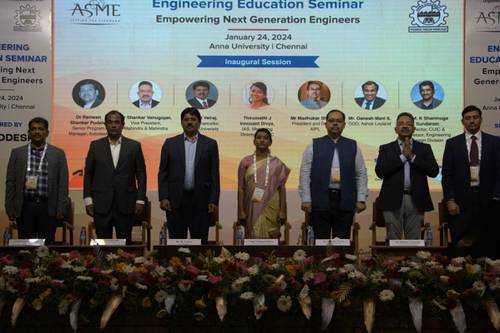What if tradition and technology can be combined to make wonders? How about a symbiosis between microbiology and motherboards? Last week, we brought you snippets from an enlightening interview with Dr. Angelo Vermeulen, crew commander of HI–SEAS (a Martian space simulation program of NASA), before he set foot in India. Here’s a glimpse into what happened at his k! Guest Lecture on 6th February 2016, where he discussed just the possibilities opened by the above questions.
The facelift Vivekananda Auditorium was packed well before the scheduled start of the lecture – atypical of a Saturday evening – and one could sense the anticipation among the student community of the campus.
The session was set in motion with the presidential address by Dr. P. Narayanaswamy, Dean (CEG), while Mr. Sairam, Student Director (CTF), introduced the speaker.
Dr. Vermeulen started off by differentiating specifics and generalisations. “Your research interests may be very specific like examining the teeth of mosquito larvae, or as diverse as exploring the whole world”, he said, emphasizing that the latter option pushed him to be a photographer, an artist and an enthusiast of linking science with simplicity.
The discussion, which went on to touch varied topics, first began with HI-SEAS. “I was not isolated like Matt Damon in The Martian; there were five other people alongside me. So, the question of being lonely and isolated never really took shape. But, what was more difficult was wearing the space suit simulator, which would go on to isolate people from the surroundings in a virtual environment”, he quipped, when asked about the months-long simulation programme he commanded.
His team’s research focussed upon making survival interesting and easier for astronauts. Since food is one aspect of space travel that approaches monotony over a period of time, the crew tried preparing their own dishes, in addition to what was scheduled. To maintain the camaraderie, he had to ensure proper communication and feedback amongst all members. “Despite the food we cooked tasting awful sometimes, the thought of ourselves having cooked it made us feel contended”, he opined, arousing rapturous laughter from the audience.

He then continued to explain entangled reality, where data from the ecosystem would be fed to computers, which would then take steps to ensure the ecosystem behaved and developed as desired. The lecture also reiterated on evolution, when the speaker talked about the concept of termite mounds which transform over a period of time. “Consider engineering and biology as organisms, say termites. They tend to evolve their course every now and then”, was his explanation while speaking about his ambitious notion of devising an evolving spacecraft, which would change shapes based on requirements.
Dr. Vermeulen, who also discussed about various other aspects like co-creation, gave a sneak peek into his projects like the Biomodd, which uses floral ecosystem built into a computer. The evening also witnessed a swarm of questions from the crowd. When asked about his thoughts on NASA’s Mars One mission, he took a dig by saying, “It is simply against human psychology. How can one make a one-way trip without knowing what is in store? Personally, I am against it. Instead, people can experiment a lot and make sure, and then venture into things like these.”
Following this reply was another question – Why is so much being spent in research on space and other planets, when there are so many issues that plague the world, requiring immediate monetary solutions? “Investments in space are a minute fraction of what constitutes research and developmental costs in destructive sectors like the military,” was his spontaneous response, before adding philosophically that exploring beyond horizons is always a part of human destiny; making a new home with a sense of belonging is a part of our future.
The lecture ended soon, but the discussions and photo sessions were endlessly going on, which implied how much the guest had impacted the students. The evening also witnessed the project launch and display of Asherah, the automated robot that would clean surface impurities in oceans and seas.
Thus concluded the first Guest Lecture of k!’16, which was the right way to set the Battle of Brains in motion.





